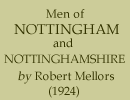< Previous | Contents | Next >
HISTORIANS and ANTIQUARIANS.
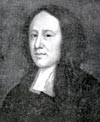
ROBERT THOROTON, (?1622, or 1623-1678), M.D., Car Colston, a descendant of the old family at Thoroton. He must be regarded in three aspects. (1) as Physician; (2) as Historian; (3) as Magistrate. He commences the Preface to his book thus:—"The Art of Physic, which I have professed (with competent success) in this county, not being able for any long time to continue the People living in it, I have charitably attempted notwithstanding the difficulty, and almost contrary to the Study, to practice upon the dead, intending thereby to Keep, all which is, or can be, left of them, to wit the Shadow of their names (better than precious ointment for the body) to preserve their Memory, as long as may be in the world." He published "The antiquities of Notts., extracted out of Records, Original Evidences, Leiger Books, other Manuscripts, and Authentic Authorities," in 1677, being moved thereto by Wm. Dugdale, Esq., Norroy king-of-arms, and following a beginning by his father-in-law, Gilbert Boun, Sergeant-at-Law. The records he then made are of great value, and much of them would otherwise have been lost. He deserves our highest gratitude for his years of labour and his public spirit in publishing his book. As a Magistrate his record is not pleasing, for being an intense Royalist he seems to have deemed it to be his duty to care for the Church and State in all parts of the County, and in the several years preceding his death he championed the cause of persecuting the Quakers. The summonses and Warrants for Distress were signed by him, the Informers appear to have been employed by him, and his Warrants were levied in places as far apart as Wellow, Sutton-in-Ashfield, Hucknall, Eakring, Kneasall, Caunton, Oxton, Collingham etc. This led to the publication of a pamphlet entitled "A True Relation of some more of the Sufferings inflicted upon the servants of God, who are call'd Quakers, in the County of Nottingham, chiefly by Penistone Whaley, and Robert Thoroton, called Justices, their making Havock and Ruin of their Innocent Neighbours Goods and Estates, 1676." After this year the persecutions are said to have ceased. The History was published the year following, and the next year he died.
CHARLES DEERING, M.D., (d. Feb. 7th, 1749). He lived on the south side of St. Peter's Church, Nottingham, and the house was pulled down when Albert Street was formed. His story was a sad one. His parentage and nationality are unknown, but it is believed that he was born in the neighbourhood of Hamburg. He graduated as M.D. at Leyden, came to England, married, and about 1735 settled in Nottingham as a medical practitioner. He in 1737 published "An Account of an impartial method of treating the Small-pox," and the next year, "A catalogue of Plants growing about Nottingham." His wife died, and her loss, with his poverty, weighed heavily on his mind. A well educated man, the master of nine languages, among strangers who knew little, and cared less, about the struggles of past generations, and their efforts for the good of posterity, he conceived the idea of compiling a history of the town, and found in John Plumptre, Esq., M.P., who lived in Plumptre House, Stoney Street, a worthy patron and helper in the supply of documents and information. He worked hard and well, for he was free from the religious narrowness and intolerance which has smeared the work of several of our local historians, and it is remarkable that we should be indebted to a foreigner for the record of much that would otherwise have been lost. But disease and poverty told on his constitution. He had collected his materials and arranged them; had got even to the dedication to the Duke of Newcastle, then Lord Lieutenant, and the address to the candid Reader, when he died. He was buried by his executors, George Ayseough, the printer, and Thomas Willington, a druggist to whom Deering was indebted, and the book was published two years afterwards, but it remained one hundred and forty-eight years longer without an index, which was in 1899 supplied by Mr. R. C. Chicken, F.R.C.S. (See Blackner, p. 340; Bailey, p. 1206; Wylie, p. 228; Ward, p. 30).
How much we owe to foreigners! One of the best books we have on our Manorial system is by a Russian professor. One of the best treatises on our Poor Law system is by a German, and, not to multiply illustrations, by far the best books on the Pilgrim Fathers and their doings before they went from our county to secure religious liberty, are by Americans. Coming nearer still, our largest local charity is due to a man (Abel Collin) whose father's settlement was opposed by the local wiseacres of the day, for they regarded him as a "foreigner," because he was not locally born. It is in the same spirit that some of us who are modern, value a man according as he belongs, or not, to "our Church," "our political party," "our Trades Union." Oh! for the arms and the heart of God, who beginning with the salvation of the individual soul, warms and widens until the whole family in earth and in heaven have been embraced, "and all flesh seas the salvation of God!"
SAMUEL CRESWELL, (1728-86), was notable by his persistent efforts to establish and extend printing in Nottingham. His mother was a daughter of Thomas Hawksley, the Jacobite Mayor, who was deposed for his misdirected loyalty to an objectionable monarch. In the house and shop at the South-west corner of the Exchange —then called the "New Change,"—Creswell carried on his business. He purchased and published "Ayscough's Weekly Courant," and renamed it "Creswell's Nottingham Journal," (1761). He published a number of books, as "Life of Frederick the Great," "Smeeton's Engineering Report on the Nottingham Canal Scheme," various Poetical books, "Pilgrim's Progress," Hammond's "Introduction to Learning," "Hammond's Dictionary," etc. His great grandson was—
The REV. SAMUEL F. CRESWELL, (1834-1904) D.D., Rector of Northrepp, Norfolk, F.R.G.S.,F.R.A.S., who in 1866 wrote a paper "Notes on the Early Typography of Notts." He supposes that printing was introduced into Nottingham by William Ayscough, in Bridle-smith Gate, in 1710, who he says may have been an offshoot of the Nuthall Ayscough's, and in 1722 the business was carried on in the name of Anne Ayscough,—the same name as the Martyr, called by Pox, in his "Book of Martyrs," Askew. He gives much information as to printers and newspapers.
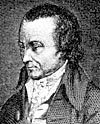
JOHN THROSBY, (1737-1803), was the son of a Mayor of Leicester, of which town and county he had written descriptions of every place of note. He was parish Clerk of S. Martin's. He re-published Thoroton's book "Antiquities of Notts," with additional information down to the date of his publication. He began his perambulations in August 1790, when the glorious sun was shining, and "a line of cheerful females were turning over the corn," which he took as a good augury, and so he bursts out with poetry, and his descriptions are modified by weather conditions, and when he gets into the drifting rain and cold and mud of the Wolds, and he meets with no hospitality, the mind sympathises with the weather conditions. He finished in the neighbourhood of Retford, his last item being dated in 1796. His "Conclusion" speaks of feeble efforts, but really they were not feeble, for he had shown great industry, perseverance, and what he calls "long and laborious labour." He published in 1777 "Memoirs of the Town and County of Leicester," in six volumes, and a "History of Leicester and Leicestershire," in 1789-91 in three volumes.
MAJOR HAYMAN ROOKE, (d. 1806), F.R.S. and A.S.S., lived in a retired mansion between Mansfield and Woodhouse, and died there after a long period of useful services to the country as a soldier, antiquary, and meteorologist; "his communications in the "Archaeologia" were very extensive in vols. 8, 9, 10 and 11." (White, 1844). In the spring of 1786 he observed small stones, which country people had called "fairy pavements," and some Roman bricks. Where could they come from? He searched about, and found in the Northfield of the parish the site of an extensive Roman Villa, with a beautiful tessellated mosaic pavement, an illustration of which may be seen in the Notts. Victoria History, vol. II. p. 28, given in an excellent paper on "Romano British Notts," by H. B. Walters, M.A., F.S.A., and other information is given in Groves "Mansfield," p. 65. Later he found another villa site near, and sepulchres, etc.
The owner of the land erected a shed to protect the treasure, but when Laird visited the site in 1811 the door was broken open, the pavement ruined, and a mare and foal were sheltering on the stones. See "Beauties of England and Wales," p. 396.
Major Rooke gave to the Society of Antiquaries accounts of the Roman camps and earthworks in the County near to Pleasley, Mansfield Woodhouse, Whinney Hill, Hexgrave, Combe, Oldox near Oxton, and Berry Hill. He compiled a list of the then officers of Sherwood Forest, and of their salaries and perquisites. He gave in 1790 a "Description or sketches of remarkable Oaks in Welbeck Park." He published a pamphlet in 1799 "A sketch of the ancient and present state of Sherwood Forest,'' in which he observed that in cutting down some trees in Birkland and Bilhagh he found cut and stamped in the body of the trees the initials of King John, James I, and William and Mary, and tells how far they were from the bark and from the centre. See illustrations in White's "Worksop, The Dukery and Sherwood Forest," p. 190.
He must have spent much time in the Forest, and possibly often had his lunch under the branches of the monarch oak—then called "the Queen's Oak," but it came to pass that the villagers called it "the Major's Oak," and still it is known as "the Major Oak."
He records that Mr. Wylde of Nettleworth, who died in 1780 at the age of eighty-two, well remembered one continuous wood between Mansfield and Nottingham.
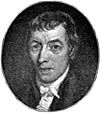
John Blackner
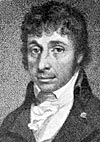
William Dickinson Rastall
JOHN BLACKNER, (1770-1816), was apprenticed to a stocking maker at Ilkeston, where he was born, and where his education was utterly neglected, and yet by force of character he became not only a contributor to the newspaper, but later on the editor of "The Nottingham Review." He was a violent politician, popular on the platform, and he became the landlord of "The Rancliffe Arms" public house. He did good service by compiling and publishing in 1815 his "History of Nottingham."
WM. DICKINSON RASTALL, (1756-1822) assumed the name of Dickinson only, resided at Southwell, thence Muskham Grange, and afterwards London. Was M.A. and J.P., and wrote several legal works. His "Antiquities" containing principally "The History of Southwell," was published in 1787 and a later edition in 1801, and gave many illustrations of the Church, its history, donors, officers, etc., as well as of the places connected therewith. "The History and Antiquities of the Town of Newark," appeared in 1806.
WILLIAM STRETTON, (1755-1828) of Lenton, was an Architect and Builder, and his father and he erected many prominent buildings, and restored or repaired many churches. He built a house in which he lived on the site of the ancient Priory (founded in 1105-8) and called his house by that name. When excavating thereon he unearthed the Font of the Priory, a work of art which is now in New Lenton Church. During his business career, and for twenty-five years after he retired, he made extensive notes and sketches of the churches and other buildings in the town and county, with their monuments, and of local events, for he having antiquarian tastes collected articles of vertu and coins, with a view to writing a history of Nottingham. These coins and sketches passed into the hands of Mr. J. T. Godfrey, and by the public spirit of Major Robertson, of Widmerpool, were copied, printed, and reproduced in a valuable two guinea volume.
JOHN HICKLIN, (b. 1805 —) was apprenticed to a Nottingham Hosiery firm, but devoted his leisure hours to literary reading and composition, and in 1826 published "Leisure Hours." He then prepared for a University course, but his health gave way, and the course had to be abandoned. In 1832 he and Mr. Job Bradshaw became joint proprietors of the "Nottingham Journal," and he became the Editor, and so continued ten years. He was secretary of the Nottingham Literary Society, before whom he read papers. He published a volume of Poems and Essays, and a "History of Nottingham Castle." He removed to Chester, becoming Editor of the "Chester Courant." He there published several books, and became secretary of a local Archaeological Society.
GRAVENER HENSON, (d. 1852, aged 67) Nottingham, "began a "History of the Frame-Work Knitting and Lace Trades;'' and in a moderate sized octavo volume published in 1831 brought his account down to the year 1780, but there ceased from the want of public support." So says Mr. Felkin, and adds that in 1828 Henson published a list of one hundred inventions and alterations in the stocking and lace machines, and left behind him "Notes of inventions and improvements of lace machines down to the year 1850." "He possessed an extraordinary memory, and delighted in the histories of manufactures and commerce."
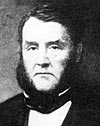
WILLIAM FELKIN, (1795-1874) J.P., lived at Derby House. He was Mayor of Nottingham in 1851 and the next year. He was agent for the firm of Heathcoat, of Tiverton, the developer of the lace trade, and he became an agent for the sale of hosiery and lace goods on commission; but he was much more. For many years he collected information as to the condition of the workers in the local trades, contributed articles to the press, gave evidence before committees of the House of Commons, and the Government Commission of Enquiry, and published papers thereon. His evidence related to Children's Employment, Hours of labour, Health, Education, Penny Postage, Corn Laws, etc. He published a valuable "History of Machine-Wrought Hosiery and Lace Manufactures," 1867, which may be regarded as a standard work of reference. In the preface he says, "Having been freed from other pressing duties, he has devoted the whole of the seventy second year of his life to this effort," which being interpreted means that having devoted his energies to the public good more than he could afford, he had impoverished himself, and his friends had purchased for him an annuity.
R. G. WAKE, Doctor of Medicine, compiled and published a History of Collingham—North and South, and of the villages which constitute the northern half of the Hundred of Newark (1867). This part is very peculiar, and constitutes a triangular wedge, driven between the parts of Lindsey in Lincolnshire, and the parts of Kesteven, and comes to a point at Brodholme, about five miles from the city of Lincoln. Why this peculiarity? Dr. Wake is able to show that the district now forming part of Nottinghamshire was, when the Danish settlement was made, a thousand years ago, partly in the water and partly out, and so was the overflow of the river Trent, and as the waters dried up, or were drained off, the villages sprang up.
The Vicar of North Collingham—the Rev. R. F. Gould, M.A.,—informs me that Dr. Wake left there, and information of him is locally unobtainable.
WILLIAM HOWIE WYLIE in 1853 published "Old and New Nottingham," a book of 380 pages, full of useful information as to the town, more than 100 pages being devoted to the biographies of "Worthies."
In 1893 there was issued "A popular History of Nottingham" by the late W. Howie Wylie and J. Potter Briscoe.
REV. JOHN RAINE, M.A., Vicar of Blythe, in 1860 compiled and published "The History and Antiquities of the Parish of Blythe, comprising accounts of the Monastery, Hospital, Chapels, and Ancient Tournament Field of the parish; of the Castle and Honour of Tickhill," and biographical notices of the families connected with the ownership, with illustrations. The ancient parish included nine other parishes or hamlets, accounts of which are given. The task he set himself to, he says, ''he had at heart for many years,'' and he did it thoroughly and well.
THOMAS CLOSE, J.P., (d. 1881), Nottingham, was an antiquary paying special attention to genealogy and heraldry, in connection with which he gave evidence in important law cases. He in 1866 published "St. Mary's Church, Nottingham; its probable Architect and Benefactor; with remarks on the Heraldic Windows described by Thornton." He was a Fellow of the Royal Society of Antiquaries, and a Chevalier of the Order of Leopold, in Belgium. He was from 1865 for thirteen years Deputy Grand-Master of the Masonic province of Nottingham, and was one of the Founders of the Reform Club in London. He died three days after the death of his wife. (See "Times" obit. 31st, Jan. 1881).
When the Roman Catholic Cathedral was built (1844) he paid the cost of painting in fresco the Chapel of the Blessed Sacrament, which was richly adorned.
JAMES SHIPMAN, F.G.S., M.J.I., (d. 1901) was Assistant Editor of the "Nottingham Daily Express;" a little man, with a big head and a large heart. His occupation was in night work; his recreation was examining geological formations in the open air. Wherever Mother Earth was disturbed he was drawn by irresistible attraction to inspect and investigate. The chapter on the "Geology of Lenton," included in Godfrey's "History of Lenton," indicates his great observation, and careful comments. "Holiday Letters of a Geologist" was one of his issues. The excavations for the formation of the Nottingham Victoria Station were a real treat to him, not for the geological formation, for this he knew from the inspection of sewers and cellars and caves, but because they revealed to him the defences of the town six hundred years ago, and he learned lessons from the site of the old Town Hall, which he revolved in his own mind, and put into shape in his little book, "Notes on the Old Town Wall of Nottingham," That little book of about 100 pages contains many illustrations of parts of ancient construction now covered, and we are indebted to Messrs. Shipman, Stevenson and Stapleton for giving unwearied attention to the railway work as it proceeded.
It was his delight to impart to others the knowledge he had gained, and he met with sympathetic hearers at the Men's Sunday Morning Institute, the Class he had formed at the Colwick Street Mission, or some Rambling Club, which he would accompany—or rather the members accompanied him, and heard what it was a pleasure to him to impart.
CECIL GEORGE SAVILE FOLJAMBE, (1846-1907), who became Lord Hawkesbury, and later Earl of Liverpool, resided twenty-eight years at Cockglode, near Ollerton, a house in a charming part of the Forest, with a fine avenue of Scotch firs, and later he went to reside at Kirkham Abbey, by the side of the Railway from York to Scarborough.
Early in life he served in the Royal Navy, and retired as Lieutenant. He was M.P. for North Nottinghamshire 1880-5, and for the Mansfield Division for seven years afterwards, and the peerage followed his defeat. On a change of government his elder brother Francis, who had been M.P. for Retford from 1857 to 1885, and later became Vice Chairman of the Nottinghamshire County Council, was made a Privy Councillor.
In 1893 Lord Hawkesbury became Earl of Liverpool, the title being revived. He was one of the founders of the Nottinghamshire Thoroton Society, and was chairman of its first Council, and later Vice-President. He took an active part in antiquarian and historical matters, and was F.S.A.
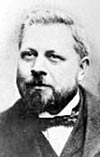
CORNELIUS BROWN, (1852-1907), Newark, was born at Lowdham, and after schooling went into the office of the "Nottingham Daily Guardian." Becoming a reporter, his work gave him an introduction to men of all classes, and exercising his powers of observation and memory he entered heartily into questions of antiquarian and historical interest, and the biographies of local men. So he started a column in the "Guardian" of "Notes about Notts." When he was only twenty-two years of age he was appointed editor of the ''Newark Advertiser, which potst he occupied during the rest of his life, conducting the paper with judicious care and skill. He was not, however, content with his editorial work, but compiled and issued a series of books on local history, including "The Worthies of Notts." a book involving great research, industry, and care (1882); "A History of Notts." (1891). His monumental work was "A History of Newark," in two volumes (1905-7) containing a mass of information published for the first time, collected from every available source, and enriched with many illustrations. The preparation of this work we are told in the obituary notice inserted in the second volume, "occupied all his spare time and energy for fifteen long years, and in his own words, "Newark is worthy of the book, and if the book prove worthy of the town my ambition and reward are alike satisfied."
There is a very pathetic interest attached to the completion of this book. He corrected the last proof for the printer, and almost as he laid down his pen, illness seized him; four days later .... his spirit passed to the land of shadows; ''his work was done; how well he had done it!"
ROBERT WHITE (1819-1908) of Worksop, was a printer and stationer, who for many years devoted his leisure time to collecting documents and materials relating to the County, or to special places therein, and printing and publishing them. His most valuable work was "The Dukery Records," being notes and memoranda illustrative of Nottinghamshire ancient History, 1904, a two guinea book, privately printed for subscribers. He had previously written a History of Worksop, and published several works on Archaeology, notably Aveling's "History of Roche Abbey," 1870.
JOHN THOMAS GODFREY, (d. 1911) of Lenton, was the author of "A History of the Parish and Priory of Lenton, 1884." "Notes on the Churches of Notts: Hundred of Rushcliffe," 1887, and the like (1907) "Hundred of Bingham." He prepared many materials for a similar work on the Hundred of Broxtowe, but these were at the time of his death handed over to a local antiquary. He abstracted the marriages down to 1812 in the three parishes of Nottingham, and these were published in four volumes, at the cost of Mr. James Ward (1901). The like remark applies to "The History_of Friar Lane Baptist Church, Nottingham," 1903, which appears with both names, as does also "The Homes and Haunts of Henry Kirk White," (1908). He wrote many biographical notes of famous Nottinghamshire men, on the lines of Brown's "Worthies," but these were not published.
From the foregoing account of Mr. J. T. Godfrey it will be seen that while the latter did the literary work, and did it well, all the financial part lay on the shoulders of Mr. James Ward, in respect of which his public spirit is to be commended. He however, did more. He purchased, or otherwise obtained, many "Manuscripts relating to the County of Nottingham," and these were transcribed and edited by Mr. Godfrey, and published with illustrations. Mr. Ward further collected many rare books, and from time to time handed them over to the Corporation Reference Library, the Libraries of Bromley House, the Mechanics Institution, the People's Hall, etc.
WILLIAM PHILLIMORE WATTS PHILLIMORE (1853-1913) M.A., B.C.L., was the son of the Medical Superintendent of Sneinton County Asylum, William Phillimore Stiff, who assumed the surname of Phillimore by Royal Licence in 1873. W. P. W. Phillimore entered Queen's College, Oxford, in 1873, and in 1876 took a Second Class in Jurisprudence and graduated B.A. In 1880 he became M.A. and B.C.L., and was admitted a Solicitor. He became widely known as a Genealogist, his best known book being "How to write the History of a Family," which first appeared in 1887, and he took the initiative in founding and promoting several Societies for the printing of Records, of which perhaps the "British Record Society," and the "Canterbury and York Society" are the most important. He was one of the promoting founders of the Thoroton Society and its Honorary Secretary, and later a Vice-President. He edited the "County Pedigrees," and published copies of many parochial registers of marriages. Mr. Phillimore died at Torquay, 9th April, 1913, and was buried in his father's vault at Bridgnorth.
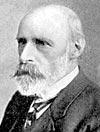
WILLIAM STEVENSON, (1832-1922), at twelve years of age went into a lace machine shop, and at fourteen into his father's wood-working shop, he being a joiner and cabinet maker, but his father dying when the son was nineteen, he succeeded to the business as a general builder. In "The Guide Book to Nottingham," in 1866, published by Richard Allen in view of the visit of the British Association, he was described as "one of our rising men,'' and therein appeared papers by him on "The Geology of Notts." and "Archaeology of Notts." He had then published a booklet on "The Building Materials of Notts." For more than half a century, although living chiefly away from Nottingham, at Hull, Scarborough, Alfreton, Mansfield, Halstead, he continued to write articles on old Nottingham History, as well as to explore his new surroundings, and so "Bygone Notts." "Ancient Earthworks" in "Victoria History," and many others appeared. On the formation of the Notts. "Thoroton (Antiquarian) Society" in 1897, he read the first paper, being on "The Early Churches of Notts." of which Society he became a Vice-President and Life Honorary Member. He also contributed to the Notts. Naturalists Society, being made a Life Honorary Member. Specimens collected by him may be seen in the Nottingham City Museum, the Hull Museum, etc. His papers are too numerous to catalogue, and in his ninetieth year he wrote, "I donot use a walking stick, am not held up in the fields by a five barred gate, and little worse than I was ten or twenty years ago." He was, however, too venturesome, went out on a cold day to inspect an old ruin, and a few weeks afterwards was laid to rest. His case was a fine illustration of a business man having an intellectual hobby that gave him relaxation, and in later years occupation, while it at the same time gave benefit to the community.
NOTTINGHAM BOROUGH RECORDS.—William H. Stevenson in 1879-1882 was under the direction of Committee of the Town Council of Nottingham, engaged in searching the archives of the Council from the earliest times, and the first volume was published in the latter year. He also prepared the second volume (1883) and the third (1885) and the fourth (1889) but in the fifth volume (1900) it was announced that Mr. Stevenson's career had been marked by distinguished success, the University of Oxford having conferred upon him a degree, and elected him to a research fellowship at Exeter College. The fifth volume was entrusted to Mr. W. T. Baker, and the sixth (1914) to Mr. E. L. Guilford, M.A., bringing the record down to 1760.
The Report on the Manuscripts of Lord Middleton, preserved in Wollaton Hall, was prepared and edited on behalf of the Historical Manuscripts Commission by Mr. Stevenson, (1911).
THE THOROTON Society, (so named in honour of Dr. Thoroton, the earliest County historian, and being an Antiquarian Society for Nottinghamshire, formed in 1897), has issued since that time an annual volume of its transactions with illustrations and articles too numerous to mention. It has also published "Transcripts belonging to the Peculiar of Southwell," edited by T. M. Blagg, F.S.A., "The Domesday of Inclosures for Notts.'' from the Returns of the Inclosure Commissioners of 1517, in the Public Record Office, edited by J. S. Leadham, M.A., 1904. Two volumes of Abstracts of the Inquisitions Post Mortem, relating to Notts., edited by W. P. W. Phillimore, M.A., B.C.L., 1485 to 1546, and the like for 1242 to 1321, edited by the Rev. J. Standish, B.A.
"The Victoria History of the County of Nottingham" edited by Wm. Page, F.S.A., to be completed in four volumes," had its first volume issued in 1906, and the second volume in 1910, the others were not issued. Among the local writers of the articles were Professors J. W. Carr, J. F. Blake and F. Granger, Messrs. B. Sturges Dodd, J. Whitaker, F. M. Stenton, W. Stevenson, H. B. Walters, the Rev. J. C. Cox, A. F. Leach and others.
E. CARTWRIGHT,
G. SAVILE,
G. FELLOWS,
See " Families."
